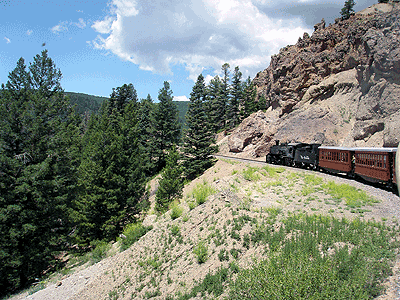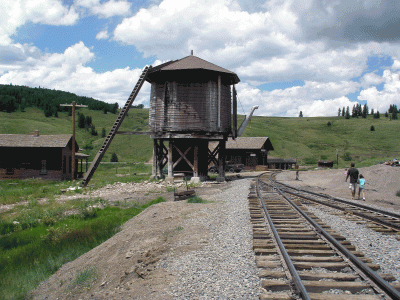By Deborah Huth Price
Berthoud Recorder
There are many ways to enjoy Colorado’s outdoor beauty, but a train may be the most magical.
For a vacation close to home, the Cumbres & Toltec Scenic Railroad is less than a day’s drive and offers some of the most spectacular views, many of which can only be seen while riding the train. The restored track, engines and cars run daily mid-May through mid-October between Antonito, Colo. and Chama, N. M., crossing the Colorado-New Mexico border 11 times.
While most modern-day experiences with trains involve waiting at crossings for freight cars to pass, passenger trains connected life across the west 100 years ago. Imagine being in the now-deserted town of Osier, hearing the whistle signal the train’s arrival. The cargo might include precious mail from a loved one, a relative coming to visit, and possibly the chance to hear news from Denver.
Deserted telegraph lines along the route are a reminder of the main method of communication in the west at that time, costing the sender for each word transmitted through the wires.
Prior to my ride on the train, I spent the week in Creede, Colo. with my family, away from internet access and cell phone signals. It’s a great way to leave connections to daily life behind. We found ourselves on the porch of our cabin every evening, gazing up at the bright stars and views of the Milky Way.
The ride on the train accented the experience. At a speed of about 10-15 miles an hour, there is lots of time to reflect on the scenery and ponder life in general. I thought of what it would be like to board the train in Antonito to visit a relative or friend in Chama. I might bring a lunch to eat — possibly to share with other passengers, take time to enjoy views of the mountains, the Los Pinos River, the Rio Chama valley, wildlife scurrying from the sound of the approaching train and perhaps write a letter to my mother back home, detailing all that I see and feel along the way.
Even in this modern age, coal still creates fire for the steam to run the train, and interaction with traffic on nearby Highway 17 is minimal. At each highway crossing, people stop and get out of their cars to wave at the passing train, taking in nostalgia of days gone by.
Railroad docent Bonsall “Doc” Johnson (Chama’s local veterinarian) explained that Highway 17 between Antonito and Chama was not built until 1923, and it was a rough dirt road until the 1950s. The train was the main transportation between the two communities. The original rail from Denver to Mexico City was started in 1880, but with the discovery of gold and silver in the mountains, a western route was built to Chama, connecting to Durango and beyond. Today only pieces of these rails remain, offering riders a look into historical travel, as well as the chance to enjoy the views along the way.
On a train, the goal is not just the destination; it’s the journey, and what a great ride it is.
The Cumbres-Toltec Scenic Railroad can be boarded either in Antonito or Chama. A bus ride takes passengers one way for about 50 miles on Highway 17, with a 64-mile return by train. A delicious hot lunch is included at the halfway point in Osier. For more information, go to www.cumbrestoltec.com.
Deborah Huth Price is Education Coordinator at Bobcat Ridge Natural Area near Masonville, and also a science educator at the Fort Collins Museum and Discovery Science Center.


<p><span style=”font-size: small;”><span style=”font-family: arial,helvetica,sans-serif;”>A restored steam engine pulls passenger cars up the mountain side between Antonito and the deserted town of Osier.<br /></span></span></p>
<p><span style=”font-size: small;”><span style=”font-family: arial,helvetica,sans-serif;”>The original Osier depot, built in 1888, is seen behind a tank that supplies water for the steam engine on the Culbres & Toltec Railroad.</span></span></p>